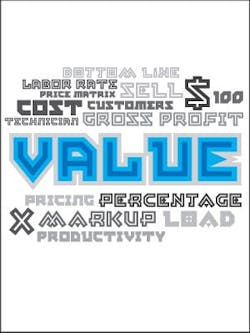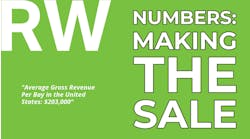Start with a list. Think about everything you want to get out of your shop, everything you want your shop to provide for customers, everything you want it to provide for your staff, your vendors, your business partners.
“What is it that you want?” asks Keith Cox, owner of Keith Cox Autobahn in Bellingham, Wash. “I want enough money to make a living and pay off debt and get retirement. I want my team to be paid on the high-end of the local parity, or higher. I want customers to get the most value possible out of my business.
“But how do you do that? I can tell how not to: competing on price. If you’re trying to make all three parties happy—the customer, shop and team member—there’s just no way to do it on a low-price model. Something has to give.”
The only way for a shop to be truly competitive in its market—any market—is to focus on value, says industry consultant Cecil Bullard. And to do that, every shop must have a consistent, accurate and profitable pricing model. Your prices need to provide value to your business, Bullard says, and they need to demonstrate to customers the value of your services.
Pricing is one of the top problems Bullard sees in shops around the country, but there’s a simple fix. Cox and Bullard explain how any shop can create a pricing model that builds value for customers and profit for the business.
Why It Works
The concept of building a price structure around value sounds abstract, even unrealistic. At best, it’s complicated and difficult to implement. At least, that’s what Bullard regularly hears from people.
It’s simply not the case, he says. Bullard did it for years in his own industry-leading shop more than a decade ago, and he’s helped shops implement this standard, consistent pricing model during his 10-plus years of consulting.
And it works. Cox is proof of that.
After altering his pricing model, Cox saw his average repair order increase from $375 to $675, and after reaching a high of $1.2 million in sales in 2013, the 4,800-square-foot, seven-employee shop is on pace for $1.6 million in 2014.
So, why does it work?
Numbers Don’t Lie. If you don’t understand your metrics, you don’t understand your business, Bullard says. And pricing all comes down to meeting the benchmark margins needed to remain profitable. (More on those later.) Simply put: If you hit those numbers, you will succeed, regardless of size, scale, specialty or market.
Profitability Relies on Pricing. Setting the correct prices is how you make money, Bullard says; it’s not for attracting customers. You can make more money on the same amount of work by simply pricing accurately, he says. And it won’t scare customers away, because …
Customers Care About More Than Price. Bullard and other industry consultants conduct many, many surveys on customer demands. And where does pricing usually fall on a customer’s list of reasons for choosing a shop? “Somewhere between number five and nine, depending on the survey,” Bullard says. The top three, nearly every time, are convenience, the car being repaired correctly the first time, and the repair being completed at the time it was promised.
“Prices are not a tool to attract people to your shop; they’re a tool to make your shop money,” Bullard says. “Value is what brings people in, and that’s what you need to sell them on.”
How It Works
For the typical repair shop, the two main profit centers are always going to be labor and parts, Cox says. Sure, supplements and additional services, when offered, should be factored in, but if you’re looking at how your shop truly brings in revenue and turns a profit, it comes down to those two areas.
And that’s where your pricing model needs to start.
Charging for Labor
Bullard sees many, many shops determining their labor rates based on other shops in their respective areas. That’s Mistake No. 1. He also sees shops intentionally drop labor rates to try to attract customers. That’s Mistake No. 2.
Determining a proper labor rate comes down to the numbers—your shop’s numbers, no one else’s.
In its simplest form, Bullard says that your labor rate should allow for a 60 percent gross profit on labor sales. But that needs to factor in the “loaded” hourly cost per technician and the shop’s productivity. (Note: Many benchmarks of 70 percent gross profit on labor do not factor in the load or productivity.)
The cost of a technician. Whether on a flat rate, salary, hourly or incentive-based pay scale, identify the amount of money you are paying per technician for each billed hour, and add on the load. (Loaded refers to including all costs of employing that technician for an hour, including benefits, vacation time, uniforms, etc. The load per technician will vary from shop to shop.) That determines your true payment to your technicians for each billed hour, not what the techs cost your business.
This is where productivity comes in. Poor productivity numbers (e.g. producing slower than book time) mean each tech will actually cost your shop more per hour than the loaded wage implies. High productivity will mean he or she costs you less.
Finalizing a Number. You do not want your profit margin on labor falling below 60 percent, so if productivity is less than 100 percent, you will need to adjust. Bullard says that means two things: Improve productivity (either through training or finding new technicians) or raise your labor rate.
Labor rates are not permanent, but your margin needs to be. Regularly check your numbers to ensure that you are meeting your benchmarks.
Charging for Parts
The general rule is to have a 58 percent gross profit on parts sales, Bullard says. Cox shoots for a round number of 60 percent. But, unlike labor rate, you don’t want to simply mark up each part to allow for a 60 percent margin, Cox says.
“Large, expensive parts, like ones in the $800 or $1,000 range, would then be way too high for a customer to ever consider paying,” he says. “The idea is to stagger the markups so you hit higher margins on cheaper parts and lower margins on more expensive parts.”
That simple concept is how price-based companies like Wal-Mart or McDonald’s remain so profitable, Bullard says. The burgers at a fast food chain, for instance, often carry a low margin, but the fries and sodas sold along with them have extremely high margins.
“It’s about having that balancing act,” Cox says.
And that’s where a price matrix comes in. A parts matrix is a simple document that gives a basic multiplier to calculate the markup on a given part.
How to Sell It
The bottom line, as Cox sees it, your shop simply can’t do it all. Providing high-quality repairs and service at an efficient pace costs money. Better parts, better staff, more time and effort put into each repair—it all adds up.
“You can’t diminish that product by trying to undercut prices,” he says.
That’s why it’s imperative to ensure customers understand the value they get at your shop. Cox explains his warranty (three years, 36,000 miles), he describes the parts used, the level of technical knowledge of his staff, and his customer service shines through in every aspect of the business.
“Customers want it done right the first time, when you said it’ll be done and with great service. That’s the bottom line,” he says. “It all comes down to that question: What is it that you want? Your prices need to satisfy everyone involved.”




